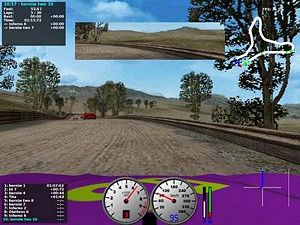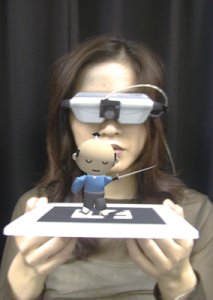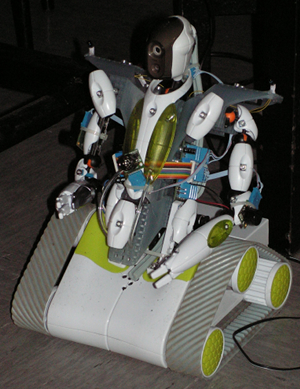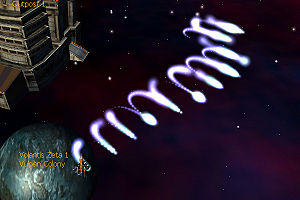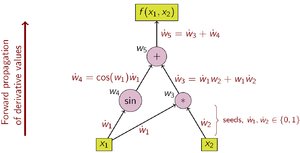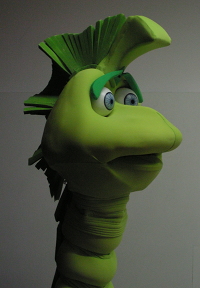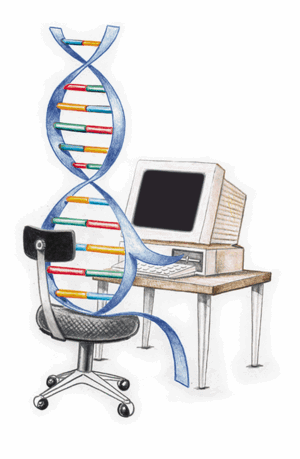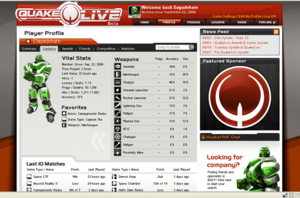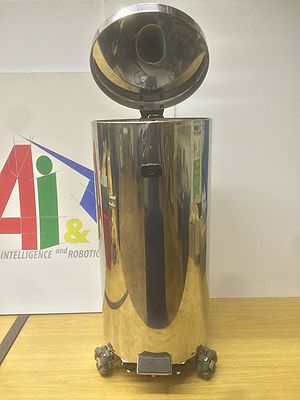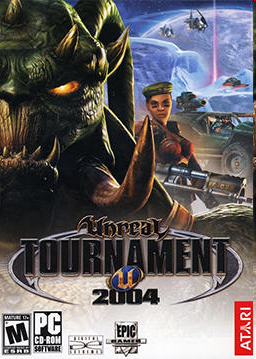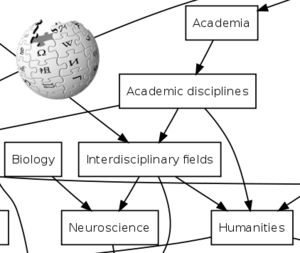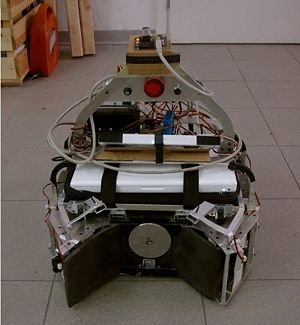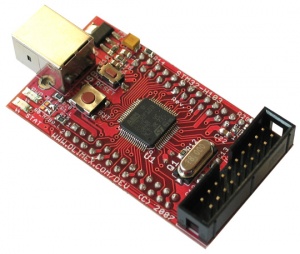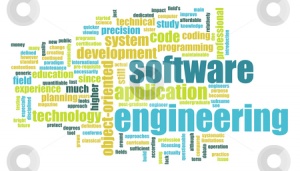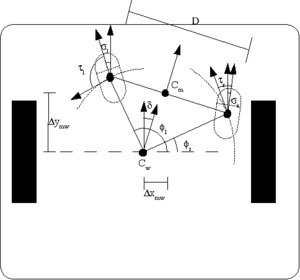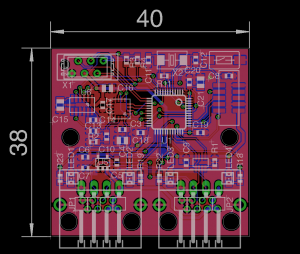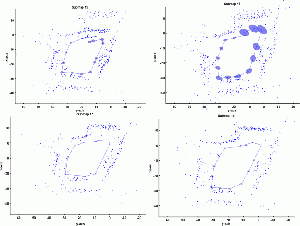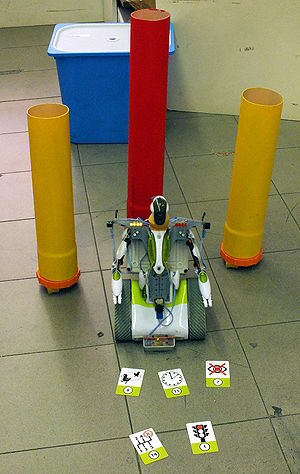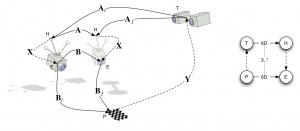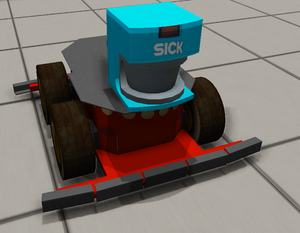Difference between revisions of "Master Level Theses"
(→Computational Intelligence and Games) |
|||
| (18 intermediate revisions by 5 users not shown) | |||
| Line 1: | Line 1: | ||
Here you can find proposals for master thesis (20 CFU for each student). See [[Project Proposals]] for other kinds of projects and theses. | Here you can find proposals for master thesis (20 CFU for each student). See [[Project Proposals]] for other kinds of projects and theses. | ||
| − | |||
| Line 6: | Line 5: | ||
==== Evolutionary Optimization and Stochastic Optimization ==== | ==== Evolutionary Optimization and Stochastic Optimization ==== | ||
| + | ==== Agents, Multiagent Systems, Agencies ==== | ||
| − | {{ | + | {{#ask: [[Category:ProjectProposal]] |
| − | + | [[PrjResArea::Agents, Multiagent Systems, Agencies]] | |
| − | + | [[PrjLevel::Ms]] | |
| − | + | [[PrjType::Thesis]] | | |
| − | + | ?PrjTitle | | |
| − | + | ?PrjImage | | |
| − | + | ?PrjDescription | | |
| − | + | ?PrjTutor | | |
| − | + | ?PrjStarts | | |
| − | + | ?PrjStudMin | | |
| − | + | ?PrjStudMax | | |
| − | + | ?PrjCFUMin | | |
| − | + | ?PrjCFUMax | | |
| − | + | ?PrjResArea | | |
| − | + | ?PrjResTopic | | |
| − | + | format = template | | |
| − | + | template = Template:ProjectProposalViz | |
| − | + | }} | |
| − | | | + | |
| − | + | ||
| − | + | ||
| − | + | ||
| − | |||
==== BioSignal Analysis ==== | ==== BioSignal Analysis ==== | ||
| Line 69: | Line 64: | ||
===== Brain-Computer Interface ===== | ===== Brain-Computer Interface ===== | ||
| − | {{ | + | {{#ask: [[Category:ProjectProposal]] |
| − | + | [[PrjResArea::BioSignal Analysis]] | |
| − | + | [[PrjResTopic::Brain-Computer Interface]] | |
| − | + | [[PrjLevel::Ms]] | |
| − | + | [[PrjType::Thesis]] | | |
| − | + | ?PrjTitle | | |
| − | : | + | ?PrjImage | |
| − | + | ?PrjDescription | | |
| − | + | ?PrjTutor | | |
| − | + | ?PrjStarts | | |
| − | + | ?PrjStudMin | | |
| − | + | ?PrjStudMax | | |
| − | + | ?PrjCFUMin | | |
| − | + | ?PrjCFUMax | | |
| − | + | ?PrjResArea | | |
| − | + | ?PrjResTopic | | |
| − | + | format = template | | |
| − | + | template = Template:ProjectProposalViz | |
| − | + | }} | |
| − | + | ||
| − | + | ||
| − | + | ||
| − | + | ||
| − | : | + | |
| − | + | ||
| − | + | ||
| − | + | ||
| − | + | ||
| − | + | ||
| − | + | ||
| − | + | ||
| − | + | ||
| − | + | ||
| − | + | ||
| − | + | ||
| − | + | ||
| − | | | + | |
| − | + | ||
| − | + | ||
| − | + | ||
| − | + | ||
| − | + | ||
| − | + | ||
| − | + | ||
| − | + | ||
| − | | | + | |
| − | | | + | |
| − | | | + | |
| − | + | ||
| − | + | ||
| − | | | + | |
| − | | | + | |
| − | | | + | |
| − | + | ||
| − | + | ||
| − | + | ||
| − | + | ||
| − | + | ||
| − | + | ||
| − | + | ||
| − | + | ||
| − | | | + | |
| − | | | + | |
| − | | | + | |
| − | + | ||
| − | + | ||
| − | | | + | |
| − | + | ||
| − | + | ||
| − | + | ||
| − | + | ||
| − | : | + | |
| − | + | ||
| − | + | ||
| − | + | ||
| − | + | ||
| − | + | ||
| − | + | ||
| − | + | ||
| − | + | ||
| − | + | ||
| − | + | ||
<!--==== Computer Vision and Image Analysis ====--> | <!--==== Computer Vision and Image Analysis ====--> | ||
| Line 158: | Line 90: | ||
==== Machine Learning ==== | ==== Machine Learning ==== | ||
| − | {{ | + | {{#ask: [[Category:ProjectProposal]] |
| − | + | [[PrjResArea::Machine Learning]] | |
| − | + | [[PrjLevel::Ms]] | |
| − | | | + | [[PrjType::Thesis]] | |
| + | ?PrjTitle | | ||
| + | ?PrjImage | | ||
| + | ?PrjDescription | | ||
| + | ?PrjTutor | | ||
| + | ?PrjStarts | | ||
| + | ?PrjStudMin | | ||
| + | ?PrjStudMax | | ||
| + | ?PrjCFUMin | | ||
| + | ?PrjCFUMax | | ||
| + | ?PrjResArea | | ||
| + | ?PrjResTopic | | ||
| + | format = template | | ||
| + | template = Template:ProjectProposalViz | ||
| + | }} | ||
| − | |||
| − | |||
| − | |||
| − | |||
| − | |||
| − | |||
| − | |||
| − | |||
| − | |||
| − | |||
| − | |||
| − | |||
| − | |||
| − | |||
| − | |||
| − | |||
| − | |||
| − | |||
{{Project template | {{Project template | ||
| Line 206: | Line 134: | ||
|cfu=20 | |cfu=20 | ||
|image=}} | |image=}} | ||
| − | |||
==== Computational Intelligence and Games ==== | ==== Computational Intelligence and Games ==== | ||
| − | + | {{#ask: [[Category:ProjectProposal]] | |
| − | {{ | + | [[PrjResTopic::Computational Intelligence and Games]] |
| − | + | [[PrjLevel::Ms]] | |
| − | + | [[PrjType::Thesis]] | | |
| − | + | ?PrjTitle | | |
| − | | | + | ?PrjImage | |
| − | | | + | ?PrjDescription | |
| − | | | + | ?PrjTutor | |
| − | | | + | ?PrjStarts | |
| − | + | ?PrjStudMin | | |
| − | + | ?PrjStudMax | | |
| − | | | + | ?PrjCFUMin | |
| − | | | + | ?PrjCFUMax | |
| − | | | + | ?PrjResArea | |
| − | | | + | ?PrjResTopic | |
| − | | | + | format = template | |
| − | | | + | template = Template:ProjectProposalViz |
| − | + | }} | |
| − | + | ||
| − | + | ||
<!--==== Affective Computing ====--> | <!--==== Affective Computing ====--> | ||
| Line 273: | Line 198: | ||
|cfu=7.5-20 | |cfu=7.5-20 | ||
|image=Robowii_robot.jpg}} | |image=Robowii_robot.jpg}} | ||
| + | |||
| + | |||
| + | |||
| + | {{#ask: [[Category:ProjectProposal]] | ||
| + | [[PrjResArea::Robotics]] | ||
| + | [[PrjLevel::Ms]] | ||
| + | [[PrjType::Thesis]] | | ||
| + | ?PrjTitle | | ||
| + | ?PrjImage | | ||
| + | ?PrjDescription | | ||
| + | ?PrjTutor | | ||
| + | ?PrjStarts | | ||
| + | ?PrjStudMin | | ||
| + | ?PrjStudMax | | ||
| + | ?PrjCFUMin | | ||
| + | ?PrjCFUMax | | ||
| + | ?PrjResArea | | ||
| + | ?PrjResTopic | | ||
| + | format = template | | ||
| + | template = Template:ProjectProposalViz | ||
| + | }} | ||
<!--==== Soft Computing ====--> | <!--==== Soft Computing ====--> | ||
Latest revision as of 19:54, 29 October 2009
Here you can find proposals for master thesis (20 CFU for each student). See Project Proposals for other kinds of projects and theses.
Contents
Evolutionary Optimization and Stochastic Optimization
Agents, Multiagent Systems, Agencies
| Wiki Page: | 3D Scene Understanding | |
| Title: | 3D Indoor scene understanding and layout reconstruction for a mobile robot in collaboration with UnimiB | |
| Description: | The proposed project aims to reconstruct the 3D structural layout of an indoor environment perceived by a mobile robot. From the sensorial data, the robot should be able to reconstruct a geometrical structure of an indoor environment (e.g., an office).
Methods for indoor layout reconstruction must be significantly more tolerant to missing data than their outdoor counterparts, since environments such as offices and apartments exhibit extremely high levels of clutter, which typically results in heavy occlusions of walls and other structures of interest, large-scale artifacts, noise and missing data. The proposed work will be developed in collaboration with IRALAB, the Robotics Lab of University of Milano Bicocca. The work will be based on an existing project, Free Your Camera (http://www.ira.disco.unimib.it/research/robotic-perception-research/free-your-camera-3d-indoor-scene-understanding-from-arbitrary-camera-motion/) and will be part of a robotic framework based on with ROS and in development at IRALAB. | |
| Tutor: | [[FrancescoAmigoni | ]] (, , , , , , , , , , , , , , , , , , … further resultswarning.png
| |
| Start: | 1 February 2015 | |
| Students: | 1 - 2 | |
| CFU: | 10 - 20 | |
| Research Area: | Robotics | |
| Research Topic: | Robotics |
| Wiki Page: | A firefox extension for semantic annotations | |
| Title: | A Firefox extension for semantic annotations | |
| Description: | Aim of this project is to develop a Firefox extension, to allow a community of users to annotate resources on the Web using a shared RDF vocabulary.
While browsing the Web, a user should be able to visualize the annotations relative to the page they are visiting, and to add new annotations as well. | |
| Tutor: | [[DavidLaniado | ]] (, , , , , , , , , , , , , , , , , , … further resultswarning.png
| |
| Start: | ||
| Students: | 1 - 2 | |
| CFU: | 5 - 20 | |
| Research Area: | Social Software and Semantic Web | |
| Research Topic: | Semantic Annotations |
| Wiki Page: | AI in Racing Games | |
| Title: | AI in Racing Games | |
| Description: | This project is focused on TORCS, a state-of-the-art open source racing simulator. From one hand, TORCS represents an ideal bechmark to study Computational Intelligence techniques. On the other hand, Computational Intelligence techniques could be used to improve the game experience in this kind of games. Several projects and theses are available on this topic, please contact us for additional information.
References:
| |
| Tutor: | [[DanieleLoiacono | ]] (, , , , , , , , , , , , , , , , , , … further resultswarning.png
| |
| Start: | 1 October 2009 | |
| Students: | 1 - 2 | |
| CFU: | 5 - 20 | |
| Research Area: | Computational Intelligence and Games | |
| Research Topic: | Computational Intelligence and Games |
| Wiki Page: | Accurate AR Marker Location | |
| Title: | C++ Library for accurate marker location based on subsequent pnp refinements | |
| Description: | ARTags, QR codes, Data Matrix, are visual landmark used for augmented reality, but they could be used for robotics as well. A thesis has already been done on using data matrix for robot localization and mapping, but improvements are required in terms generality, accuracy and robustness of the solution. The goal is thuss to:
Material:
Expected outcome:
Required skills or skills to be acquired:
| |
| Tutor: | [[MatteoMatteucci | ]] (, , , , , , , , , , , , , , , , , , … further resultswarning.png
| |
| Start: | 1 January 2015 | |
| Students: | 1 - 2 | |
| CFU: | 5 - 10 | |
| Research Area: | Computer Vision and Image Analysis | |
| Research Topic: | None |
| Wiki Page: | Annotation aggregators from social applications | |
| Title: | Annotation aggregators from social applications | |
| Description: | Annotations are metadata published about a resource, such as tags in del.icio.us, comments on stumbleupon.com, or twines on Twine.com. One of the main problems of these annotations is that they are not expressed in a standard format: thus, any tool trying to aggregate information from these sources should be able to access each one of them in a different way.
The purpose of this project is to develop translation tools for different social annotation systems, collect their data in a common format (expressed using an ontology), and show them through a unique user interface, able to display different annotations (i.e. geo coordinates, dates, tags, etc.) in different ways. Moreover, tests and evaluations should be performed on this aggregator to show how efficient the queries are when performed on-the-fly or from an intermediate knowledge base. | |
| Tutor: | [[DavideEynard | ]] (, , , , , , , , , , , , , , , , , , … further resultswarning.png
| |
| Start: | ||
| Students: | 1 - 2 | |
| CFU: | 5 - 20 | |
| Research Area: | Social Software and Semantic Web | |
| Research Topic: | Semantic Annotations |
| Wiki Page: | Autistic Children Play Robot | |
| Title: | Autistic Children Play Robot | |
| Description: | Within a Polisocial project we will have to implement a robot suitable to play autonomously with autistic children that will interact with it and a game system by gestures.
The thesis will explore some of the aspects of the problem, eventually participating to the production of prototypes to be tested with real users. The thesis gives the possibility to develop a robot with special requirements, and to work with gesture interpretation by using devices such as Kinect or the WII Mote. The work is done in an interdisciplinary group including care givers and designers. | |
| Tutor: | [[AndreaBonarini | ]] (, , , , , , , , , , , , , , , , , , … further resultswarning.png
| |
| Start: | 20 January 2015 | |
| Students: | 1 - 2 | |
| CFU: | 20 - 20 | |
| Research Area: | Robotics | |
| Research Topic: | Robogames |
| Wiki Page: | Automatic Content Generation in Computer Games | |
| Title: | Automatic Content Generation in Computer Games | |
| Description: | The generation of customized game content for each player is an attractive direction to improve the game experience in the next-generation computer games. In this scenario, Machine Learning could play an important role to provide automatically such customized game content. Several projects and theses are available on this topic, please contact us for additional information.
Picture taken from http://gar.eecs.ucf.edu/
| |
| Tutor: | [[DanieleLoiacono | ]] (, , , , , , , , , , , , , , , , , , … further resultswarning.png
| |
| Start: | 1 October 2009 | |
| Students: | 1 - 2 | |
| CFU: | 5 - 20 | |
| Research Area: | Computational Intelligence and Games | |
| Research Topic: | Computational Intelligence and Games |
| Wiki Page: | Automatic Differentiation Techniques for Real Time Kalman Filtering | |
| Title: | Evaluation of Automatic Differentiation Techniques for Gauss-Newton based Simultaneous Localization and Mapping | |
| Description: | In Gauss-Newton non linear optimization one of the most tedious part is computing Jacobians. At the AIRLab we have developed a framework for non linear Simultaneous Localization and Mapping suitable for different motion models and measurement equations, but any time you need to change something you need to recompute the required Jacobian. Automatic differentiation is a tool for the automatic differentiation of source code either at compiling time or at runtime; we are interested in testing these techniques in the software we have developed and compare their performance with respect to (cumbersome) optimized computation.
Material
Expected outcome: New modules implementations based on automatic differentiation A comparison between the old stuff and new approach Required skills or skills to be acquired:
| |
| Tutor: | [[MatteoMatteucci | ]] (, , , , , , , , , , , , , , , , , , … further resultswarning.png
| |
| Start: | 1 January 2015 | |
| Students: | 1 - 2 | |
| CFU: | 10 - 20 | |
| Research Area: | Robotics | |
| Research Topic: | None |
| Wiki Page: | Automatic generation of domain ontologies | |
| Title: | Automatic generation of domain ontologies | |
| Description: | This thesis to be developed together with Noustat S.r.l. (see http://www.noustat.it), who are developing research activities directed toward the optimization of knowledge management services, in collaboration with another company operating in this field. This project is aimed at removing the ontology building bottleneck, long and expensive activity that usually requires the direct collaboration of a domain expert. The possibility of automatic building the ontology, starting from a set of textual documents related to a specific domain, is expected to improve the ability to provide the knowledge management service, both by reducing the time-to-application, and by increasing the number of domains that can be covered. For this project, unsupervised learning methods will be applied in sequence, exploiting the topological properties of the ultra-metric spaces that emerge from the taxonomic structure of the concepts present in the texts, and associative methods will extend the concept network to lateral, non-hierarchical relationships. | |
| Tutor: | [[MatteoMatteucci | ]] (, , , , , , , , , , , , , , , , , , … further resultswarning.png
| |
| Start: | ||
| Students: | 1 - 2 | |
| CFU: | 20 - 20 | |
| Research Area: | Machine Learning |
| Wiki Page: | Barking Robots | |
| Title: | Barking Robots | |
| Description: | Aim of this project is the development of a robot that can operate autonomously at exhibitions and malls to attract people to a given location, by showing interesting behaviors and interacting with people.
The robot first exhibition has been at Robotica 2009, within HI-Tech Expo at Fiera di Milano, on November 23-25, 2009. Here, the robot had to go around in an area delimited by a white stripe and contact verbally and with gestures people entering the area, in order to attract them to the booth. Behaviors and gestures have still to be developed to come to an interesting and robust demo at next Robotica, or at other ehibits (e.g. at the Museo della Scienza of Milan). | |
| Tutor: | [[AndreaBonarini | ]] (, , , , , , , , , , , , , , , , , , … further resultswarning.png
| |
| Start: | 25 February 2012 | |
| Students: | 1 - 2 | |
| CFU: | 5 - 20 | |
| Research Area: | Robotics | |
| Research Topic: | Robot development |
| Wiki Page: | Behavior recognition from visual data | |
| Title: | Behavior recognition from visual data | |
| Description: | In the literature several approaches have been used to model observed behaviors and these date back to early approaches in animal behavior analysis (Baum and Eagon, 1967)(Colgan, 1978). Nowadays several techniques are used and they can be roughly classified as: State space models, Automata (e.g., Finite State Machines, Agents, etc.), Grammars (e.g., strings, T-Patterns, etc.), Bayeasian models (e.g., Hidden Markov Models), and Dynamic State Variables. The work will leverage on a huge corpus of techniques to devise the most suitable for behavior recognition from visual data. We exclude from the very beginning any deterministic approach being the phenomenon under observation complex and affected by noisy observations. The focus will be mainly of the use of dynamic graphical models (Ghahramani, 1998) and the application of bottom up learning techniques (Stolcke and Omohundro, 1993)(Stolcke and Omohundro, 1994) for model induction.
Material:
Expected outcome:
Required skills or skills to be acquired:
| |
| Tutor: | [[MatteoMatteucci | ]] (, , , , , , , , , , , , , , , , , , … further resultswarning.png
| |
| Start: | 1 April 2012 | |
| Students: | 1 - 2 | |
| CFU: | 20 - 20 | |
| Research Area: | Machine Learning | |
| Research Topic: | None |
| Wiki Page: | BringMeHome | |
| Title: | BringMeHome | |
| Description: | ||
| Tutor: | [[AndreaBonarini | ]] (, , , , , , , , , , , , , , , , , , … further resultswarning.png
| |
| Start: | 30 March 2013 | |
| Students: | 1 - 2 | |
| CFU: | 2 - 20 | |
| Research Area: | Robotics | |
| Research Topic: | E-2? - A robot for exhibitions |
| Wiki Page: | Cognitive SLAM | |
| Title: | Cognitive SLAM | |
| Description: | We have developed a system that is able to detect, recognize and track objects in an image taken from a low cost robot equipped with a IMU and a low cost camera. The system is capable to detect and recognize objects using a user defined fuzzy tree classifier. However the system performance is heavily dependent on high level feature extraction, such as geometric features. The problem is non trivial due to noisy low cost camera and changes in the light conditions. The aim of this project is to improve the feature extraction and description process, both in performance and quality, possible adding a more complete description or others type of features. The long term aim of the research is to have an autonomuos robot capable to create a semantic map of the envirorment, localize himself , make inference on the map, navigate into the envirorment using the objects as landmarks.
No special skills are required, except basic c and object oriented programming. | |
| Tutor: | [[AndreaBonarini | ]] (, , , , , , , , , , , , , , , , , , … further resultswarning.png
| |
| Start: | 1 January 2015 | |
| Students: | 1 - 2 | |
| CFU: | 5 - 20 | |
| Research Area: | Robotics | |
| Research Topic: | SLAM, Feature Extraction |
| Wiki Page: | Combinatorial optimization based on stochastic relaxation | |
| Title: | Combinatorial optimization based on stochastic relaxation | |
| Description: | The project will focus on the study, implementation, comparison and
analysis of different algorithms for the optimization of pseudo-Boolean functions, i.e., functions defined over binary variables with values in R. These functions have been studied a lot in the mathematical programming literature, and different algorithms have been proposed (1). More recently, the same problems have been faced in evolutionary computations, with the use of genetic algorithms, and in particular estimation of distribution algorithms (2,3). Estimation of distribution algorithms are a recent meta-heuristic, where classical crossover and mutation operators used in genetic algorithms are replaced with operators that come from statistics, such as sampling and estimation. The focus will be on the implementation of a new algorithm able to combine different approaches (estimation and sampling, from one side, and exploitation of prior knowledge about the structure of problem, on the other), together with the comparison of the results with existing techniques that historically appear in different (and often separated) communities. Good coding (C/C++) abilities are required. Since the approach will be based on statistical models, the student is supposed to be comfortable with notions that come from probability and statistics courses. The project could require some extra effort in order to build and consolidate some background in math, especially in Bayesian statistics and MCMC techniques, such as Gibbs and Metropolis samplers (4). The project can be extended to master thesis, according to interesting and novel directions of research that will emerge in the first part of the work. Possible ideas may concern the proposal of new algorithms able to learn existing dependencies among the variables in the function to be optimized, and exploit them in order to increase the probability to converge to the global optimum. Picture taken from http://www.ra.cs.uni-tuebingen.de/ Bibliography
| |
| Tutor: | [[MatteoMatteucci | ]] (, , , , , , , , , , , , , , , , , , … further resultswarning.png
| |
| Start: | 1 October 2009 | |
| Students: | 1 - 2 | |
| CFU: | 5 - 20 | |
| Research Area: | Machine Learning | |
| Research Topic: | Information Geometry, Stochastic Optimization |
| Wiki Page: | Combining Estimation of Distribution Algorithms and other Evolutionary techniques for combinatorial optimization | |
| Title: | Combining Estimation of Distribution Algorithms and other Evolutionary techniques for combinatorial optimization | |
| Description: | The project will focus on the study, implementation, comparison and analysis of different algorithms for combinatorial optimization using techniques and algorithms proposed in Evolutionary Computation. In particular we are interested in the study of Estimation of Distribution Algorithms (1,2,3,4), a recent meta-heuristic, often presented as an evolution of Genetic Algorithms, where classical crossover and mutation operators, used in genetic algorithms, are replaced with operators that come from statistics, such as sampling and
estimation. The focus will be on the implementation of new hybrid algorithms able to combine estimation of distribution algorithms with different approaches available in the evolutionary computation literature, such as genetic algorithms and evolutionary strategies, together with other local search techniques. Good coding (C/C++) abilities are required. Some background in combinatorial optimization form the "Fondamenti di Ricerca Operativa" is desirable. The project could require some effort in order to build and consolidate some background in MCMC techniques, such as Gibbs and Metropolis samplers (4). The project could be extended to master thesis, according to interesting and novel directions of research that will emerge in the first part of the work. Computer vision provides a large number of optimization problems, such as new-view synthesis, image segmentation, panorama stitching and texture restoration, among the others, (6). One common approach in this context is based on the use of binary Markov Random Fields and on the formalization of the optimization problem as the minimum of an energy function expressed as a square-free polynomial, (5). We are interested in the proposal, comparison and evaluation of different Estimation of Distribution Algorithms for solving real world problems that appear in computer vision. Pictures taken from http://www.genetic-programming.org and (6) Bibliography
| |
| Tutor: | [[MatteoMatteucci | ]] (, , , , , , , , , , , , , , , , , , … further resultswarning.png
| |
| Start: | 1 October 2009 | |
| Students: | 1 - 2 | |
| CFU: | 5 - 10 | |
| Research Area: | Machine Learning | |
| Research Topic: | Evolutionary Computation, Stochastic Optimization |
| Wiki Page: | Comparison of State of the Art Visual Odometry Systems | |
| Title: | A Comparison of State of the Art Visual Odometry Systems (Monocular and Stereo) | |
| Description: | Visual odometry is the estimation of camera(s) movement from a sequence of images. In case we deal with a single camera system we have Monocular Visual Odometry; in case we have more cameras we have a Stero Visual Odometry. The goal of the thesis is to review the state of the art on in visual odometry, classify existing approaches and compare their implementations (many of the algorithms have online source code available).
Material
Expected outcome:
Required skills or skills to be acquired:
| |
| Tutor: | [[MatteoMatteucci | ]] (, , , , , , , , , , , , , , , , , , … further resultswarning.png
| |
| Start: | 1 January 2015 | |
| Students: | 1 - 2 | |
| CFU: | 10 - 20 | |
| Research Area: | Computer Vision and Image Analysis | |
| Research Topic: | None |
| Wiki Page: | Creation of new EEG training by introduction of noise | |
| Title: | Creation of new EEG training by introduction of noise | |
| Description: | A Brain-Computer Interface (BCI) must be trained on the individual user in order to be effective. This training phase require recording data in long sessions, which is time consuming and boring for the user. The aim of this project is to develop algorithm to create new training EEG (electroencephalography) data from existing ones, so as to speed up the training phase.
| |
| Tutor: | [[MatteoMatteucci | ]] (, , , , , , , , , , , , , , , , , , … further resultswarning.png
| |
| Start: | 1 October 2009 | |
| Students: | 1 - 2 | |
| CFU: | 5 - 20 | |
| Research Area: | BioSignal Analysis | |
| Research Topic: | Brain-Computer Interface |
| Wiki Page: | Data Mining in Computer Games | |
| Title: | Data Mining in Computer Games | |
| Description: | Today a lot of data can be extracted from popular games. The analysis of such data allow to discover a lot of interesting information about players, the game and the interaction between the game and different type of players.
Several theses and projects are available on this topic and involve different games: TORCS, Unreal Tournament and Quake Live. Please contact us for additional information.
| |
| Tutor: | [[DanieleLoiacono | ]] (, , , , , , , , , , , , , , , , , , … further resultswarning.png
| |
| Start: | 1 October 2009 | |
| Students: | 1 - 2 | |
| CFU: | 5 - 20 | |
| Research Area: | Computational Intelligence and Games | |
| Research Topic: | Computational Intelligence and Games |
| Wiki Page: | Designing Living Objects | |
| Title: | Designing Living Objects | |
| Description: | The aim of this activity is to investigate how one or more objects in an antropic environment (home, office, hospital) can be designed and implemented to have a character and to move, having nice interactions with people. The work to be done concerns the analysis, definition, design and implementation of at least one of these objects. | |
| Tutor: | [[AndreaBonarini | ]] (, , , , , , , , , , , , , , , , , , … further resultswarning.png
| |
| Start: | 15 October 2017 | |
| Students: | 1 - 2 | |
| CFU: | 5 - 20 | |
| Research Area: | Robotics | |
| Research Topic: | Living Objects |
| Wiki Page: | Detecting patterns in ontology usage | |
| Title: | Detecting patterns in ontology usage | |
| Description: | When building a new knowledge base the reuse of existing, well known vocabularies is often desirable. However, sometimes it is not clear which ontology should be preferable or which term is best suited for a specific application. Aim of this project is to detect patterns in ontology usage by harvesting ontologies which use a given schema (i.e. Foaf or Dublin Core) and analysing how people are using them in practice. The resulting application should download ontologies from the main semantic search engines (such as http://watson.kmi.open.ac.uk/ and http://sindice.com/), parse them and calculate statistics about the terms used inside them. The tool should show these statistics, save them in an appropriate format and make them available through an API for use by external applications. | |
| Tutor: | [[DavideEynard | ]] (, , , , , , , , , , , , , , , , , , … further resultswarning.png
| |
| Start: | ||
| Students: | 1 - 2 | |
| CFU: | 5 - 20 | |
| Research Area: | Social Software and Semantic Web | |
| Research Topic: | Semantic Annotations |
… further resultswarning.png"Agents, Multiagent Systems, Agencies" is not in the list of possible values (Affective Computing, Agents - Multiagent Systems - Agencies, BioSignal Analysis, Computational Intelligence and Games, Computer Vision and Image Analysis, E-Science, Machine Learning, Philosophy of Artificial Intelligence, Robotics, Social Software and Semantic Web) for this property.
BioSignal Analysis
Analysis of the Olfactory Signal
| Title: | Computational Intelligence techniques to analyse the olfactory signal acquired by an electronic nose for cancer diagnosis | |
|---|---|---|
| Description: | The electronic nose is an instrument able to detect and recognize odors, that is the volatile substances in the atmosphere or emitted by the analyzed substance. This device can react to a gas substance by providing signals that can be analyzed to classify the input. It is composed of a sensor array (MOS sensors, in our case) and a pattern classification system based on machine learning techniques. Each sensor reacts in a different way to the analyzed substance, providing multidimensional data that can be considered as a unique olfactory blueprint of the analyzed substance. We have already tested the use of the electronic nose as diagnostic tool for lung cancer; boosted from the very satisfactory results that we have achieved by these analysis, we want to investigate the possibility of diagnosing other types of cancer and to improve the current computation intelligence techniques.
The project is done in collaboration with the Istituto dei Tumori, Milano.
| |
| Tutor: | Andrea Bonarini (email), Matteo Matteucci (email), Rossella Blatt (email) | |
| Start: | Anytime (a new acquisition phase will start in March) | |
| Number of students: | 1-2 | |
| CFU: | 20 |
Sleep Staging
| Title: | Development of a computer-assisted CAP (Sleep cyclic alternating pattern) scoring method | |
|---|---|---|
| Description: | In 1985, Terzano describes for the first time the Cyclic Alternating Pattern [1] during sleep and, nowadays, CAP is widely accepted by the medical community as basic analysis of sleep. The CAP evaluation is of fundamental importance since it represents the mechanism developed by the brain evolution to monitor the inner and outer world and to assure the survival during sleep. However, visual detection of CAP in polisomnography (i.e., the standard procedure) is a slow and time-consuming process. This limiting factor generates the necessity of new computer-assisted scoring methods for fast CAP evaluation. This thesis deals with the development of a Decision Support System for CAP scoring based on features extraction at multi-system level (by statistical and signal analysis) and Pattern Recognition or Machine Learning approaches. This may allow the automatic detection of CAP sleep and could be integrated, through reinforcement learning techniques, with the corrections given by physicians.
| |
| Tutor: | Matteo Matteucci (email), Martin Mendez (email), Anna Maria Bianchi (email), Mario Terzano (Ospedale di Parma) | |
| Start: | Anytime | |
| Number of students: | 1-2 | |
| CFU: | 20 |
Brain-Computer Interface
| Wiki Page: | Creation of new EEG training by introduction of noise | |
| Title: | Creation of new EEG training by introduction of noise | |
| Description: | A Brain-Computer Interface (BCI) must be trained on the individual user in order to be effective. This training phase require recording data in long sessions, which is time consuming and boring for the user. The aim of this project is to develop algorithm to create new training EEG (electroencephalography) data from existing ones, so as to speed up the training phase.
| |
| Tutor: | [[MatteoMatteucci | ]] (, , , , , , , , , , , , , , , , , , … further resultswarning.png
| |
| Start: | 1 October 2009 | |
| Students: | 1 - 2 | |
| CFU: | 5 - 20 | |
| Research Area: | BioSignal Analysis | |
| Research Topic: | Brain-Computer Interface |
| Wiki Page: | Exploratory data analysis by genetic feature extraction | |
| Title: | Exploratory data analysis by genetic feature extraction | |
| Description: | Understanding the waves in EEG signals is an hard task and psicologists often need automatic tools to perform this task. In this project we are interested in using a genetic algorithm developed for P300 feature extraction in order to extract useful informations from Error Potentials. The project is a collaboration with the psicology department od Padua University.
| |
| Tutor: | [[MatteoMatteucci | ]] (, , , , , , , , , , , , , , , , , , … further resultswarning.png
| |
| Start: | 1 October 2009 | |
| Students: | 1 - 2 | |
| CFU: | 5 - 20 | |
| Research Area: | BioSignal Analysis | |
| Research Topic: | Brain-Computer Interface |
Machine Learning
| Wiki Page: | Automatic generation of domain ontologies | |
| Title: | Automatic generation of domain ontologies | |
| Description: | This thesis to be developed together with Noustat S.r.l. (see http://www.noustat.it), who are developing research activities directed toward the optimization of knowledge management services, in collaboration with another company operating in this field. This project is aimed at removing the ontology building bottleneck, long and expensive activity that usually requires the direct collaboration of a domain expert. The possibility of automatic building the ontology, starting from a set of textual documents related to a specific domain, is expected to improve the ability to provide the knowledge management service, both by reducing the time-to-application, and by increasing the number of domains that can be covered. For this project, unsupervised learning methods will be applied in sequence, exploiting the topological properties of the ultra-metric spaces that emerge from the taxonomic structure of the concepts present in the texts, and associative methods will extend the concept network to lateral, non-hierarchical relationships. | |
| Tutor: | [[MatteoMatteucci | ]] (, , , , , , , , , , , , , , , , , , … further resultswarning.png
| |
| Start: | ||
| Students: | 1 - 2 | |
| CFU: | 20 - 20 | |
| Research Area: | Machine Learning |
| Wiki Page: | Behavior recognition from visual data | |
| Title: | Behavior recognition from visual data | |
| Description: | In the literature several approaches have been used to model observed behaviors and these date back to early approaches in animal behavior analysis (Baum and Eagon, 1967)(Colgan, 1978). Nowadays several techniques are used and they can be roughly classified as: State space models, Automata (e.g., Finite State Machines, Agents, etc.), Grammars (e.g., strings, T-Patterns, etc.), Bayeasian models (e.g., Hidden Markov Models), and Dynamic State Variables. The work will leverage on a huge corpus of techniques to devise the most suitable for behavior recognition from visual data. We exclude from the very beginning any deterministic approach being the phenomenon under observation complex and affected by noisy observations. The focus will be mainly of the use of dynamic graphical models (Ghahramani, 1998) and the application of bottom up learning techniques (Stolcke and Omohundro, 1993)(Stolcke and Omohundro, 1994) for model induction.
Material:
Expected outcome:
Required skills or skills to be acquired:
| |
| Tutor: | [[MatteoMatteucci | ]] (, , , , , , , , , , , , , , , , , , … further resultswarning.png
| |
| Start: | 1 April 2012 | |
| Students: | 1 - 2 | |
| CFU: | 20 - 20 | |
| Research Area: | Machine Learning | |
| Research Topic: | None |
| Wiki Page: | Combinatorial optimization based on stochastic relaxation | |
| Title: | Combinatorial optimization based on stochastic relaxation | |
| Description: | The project will focus on the study, implementation, comparison and
analysis of different algorithms for the optimization of pseudo-Boolean functions, i.e., functions defined over binary variables with values in R. These functions have been studied a lot in the mathematical programming literature, and different algorithms have been proposed (1). More recently, the same problems have been faced in evolutionary computations, with the use of genetic algorithms, and in particular estimation of distribution algorithms (2,3). Estimation of distribution algorithms are a recent meta-heuristic, where classical crossover and mutation operators used in genetic algorithms are replaced with operators that come from statistics, such as sampling and estimation. The focus will be on the implementation of a new algorithm able to combine different approaches (estimation and sampling, from one side, and exploitation of prior knowledge about the structure of problem, on the other), together with the comparison of the results with existing techniques that historically appear in different (and often separated) communities. Good coding (C/C++) abilities are required. Since the approach will be based on statistical models, the student is supposed to be comfortable with notions that come from probability and statistics courses. The project could require some extra effort in order to build and consolidate some background in math, especially in Bayesian statistics and MCMC techniques, such as Gibbs and Metropolis samplers (4). The project can be extended to master thesis, according to interesting and novel directions of research that will emerge in the first part of the work. Possible ideas may concern the proposal of new algorithms able to learn existing dependencies among the variables in the function to be optimized, and exploit them in order to increase the probability to converge to the global optimum. Picture taken from http://www.ra.cs.uni-tuebingen.de/ Bibliography
| |
| Tutor: | [[MatteoMatteucci | ]] (, , , , , , , , , , , , , , , , , , … further resultswarning.png
| |
| Start: | 1 October 2009 | |
| Students: | 1 - 2 | |
| CFU: | 5 - 20 | |
| Research Area: | Machine Learning | |
| Research Topic: | Information Geometry, Stochastic Optimization |
| Wiki Page: | Combining Estimation of Distribution Algorithms and other Evolutionary techniques for combinatorial optimization | |
| Title: | Combining Estimation of Distribution Algorithms and other Evolutionary techniques for combinatorial optimization | |
| Description: | The project will focus on the study, implementation, comparison and analysis of different algorithms for combinatorial optimization using techniques and algorithms proposed in Evolutionary Computation. In particular we are interested in the study of Estimation of Distribution Algorithms (1,2,3,4), a recent meta-heuristic, often presented as an evolution of Genetic Algorithms, where classical crossover and mutation operators, used in genetic algorithms, are replaced with operators that come from statistics, such as sampling and
estimation. The focus will be on the implementation of new hybrid algorithms able to combine estimation of distribution algorithms with different approaches available in the evolutionary computation literature, such as genetic algorithms and evolutionary strategies, together with other local search techniques. Good coding (C/C++) abilities are required. Some background in combinatorial optimization form the "Fondamenti di Ricerca Operativa" is desirable. The project could require some effort in order to build and consolidate some background in MCMC techniques, such as Gibbs and Metropolis samplers (4). The project could be extended to master thesis, according to interesting and novel directions of research that will emerge in the first part of the work. Computer vision provides a large number of optimization problems, such as new-view synthesis, image segmentation, panorama stitching and texture restoration, among the others, (6). One common approach in this context is based on the use of binary Markov Random Fields and on the formalization of the optimization problem as the minimum of an energy function expressed as a square-free polynomial, (5). We are interested in the proposal, comparison and evaluation of different Estimation of Distribution Algorithms for solving real world problems that appear in computer vision. Pictures taken from http://www.genetic-programming.org and (6) Bibliography
| |
| Tutor: | [[MatteoMatteucci | ]] (, , , , , , , , , , , , , , , , , , … further resultswarning.png
| |
| Start: | 1 October 2009 | |
| Students: | 1 - 2 | |
| CFU: | 5 - 10 | |
| Research Area: | Machine Learning | |
| Research Topic: | Evolutionary Computation, Stochastic Optimization |
| Wiki Page: | Information geometry and machine learning | |
| Title: | Information geometry and machine learning | |
| Description: | In machine learning, we often introduce probabilistic models to handle uncertainty in the data, and most of the times due to the computational cost, we end up selecting (a priori, or even at run time) a subset of all possible statistical models for the variables that appear in the problem. From a geometrical point of view, we work with a subset (of points) of all possible statistical models, and the choice of the fittest model in out subset can be interpreted as a the point (distribution) minimizing some distance or divergence function w.r.t. the true distribution from which the observed data are sampled. From this perspective, for instance, estimation procedures can be considered as projections on the statistical model and other statistical properties of the model can be understood in geometrical terms. Information Geometry (1,2) can be described as the study of statistical properties of families of probability distributions, i.e., statistical models, by means of differential and Riemannian geometry.
Information Geometry has been recently applied in different fields, both to provide a geometrical interpretation of existing algorithms, and more recently, in some contexts, to propose new techniques to generalize or improve existing approaches. Once the student is familiar with the theory of Information Geometry, the aim of the project is to apply these notions to existing machine learning algorithms. Possible ideas are the study of a particular model from the point of view of Information Geometry, for example as Hidden Markov Models, Dynamic Bayesian Networks, or Gaussian Processes, to understand if Information Geometry can give useful insights with such models. Other possible direction of research include the use of notions and ideas from Information Geometry, such as the mixed parametrization based on natural and expectation parameters (3) and/or families of divergence functions (2), in order to study model selection from a geometric perspective. For example by exploiting projections and other geometric quantities with "statistical meaning" in a statistical manifold in order to chose/build the model to use for inference purposes. Since the project has a theoretical flavor, mathematical inclined students are encouraged to apply. The project requires some extra effort in order to build and consolidate some background in math, partially in differential geometry, and especially in probability and statistics. Bibliography
| |
| Tutor: | [[MatteoMatteucci | ]] (, , , , , , , , , , , , , , , , , , … further resultswarning.png
| |
| Start: | 1 October 2009 | |
| Students: | 1 - 2 | |
| CFU: | 20 - 20 | |
| Research Area: | Machine Learning | |
| Research Topic: | Information Geometry |
| Wiki Page: | LARS and LASSO in non Euclidean Spaces | |
| Title: | LARS and LASSO in non Euclidean Spaces | |
| Description: | LASSO (1) and more recently LARS (2) are two algorithms proposed for linear regression tasks. In particular LASSO solves a least-squares (quadratic) optimization problem with a constrain that limits the sum of the absolute value of the coefficients of the regression, while LARS can be considered as a generalization of LASSO, that provides a more computational efficient way to obtain the solution of the regression problem simultaneously for all values of the constraint introduced by LASSO.
One of the common hypothesis in regression analysis is that the noise introduced in order to model the linear relationship between regressors and dependent variable has a Gaussian distribution. A generalization of this hypothesis leads to a more general framework, where the geometry of the regression task is no more Euclidean. In this context different estimation criteria, such as maximum likelihood estimation and other canonical divergence functions do not coincide anymore. The target of the project is to compare the different solutions associated to different criteria, for example in terms of robustness, and propose generalization of LASSO and LARS in non Euclidean contexts. The project will focus on the understanding of the problem and on the implementation of different algorithms, so (C/C++ or Matlab or R) coding will be required. Since the project has also a theoretical flavor, mathematical inclined students are encouraged to apply. The project may require some extra effort in order to build and consolidate some background in math, especially in probability and statistics. Picture taken from (2) Bibliography
| |
| Tutor: | [[MatteoMatteucci | ]] (, , , , , , , , , , , , , , , , , , … further resultswarning.png
| |
| Start: | 1 October 2009 | |
| Students: | 1 - 2 | |
| CFU: | 20 - 20 | |
| Research Area: | Machine Learning | |
| Research Topic: | Informtion Geometry |
| Wiki Page: | Statistical inference for phylogenetic trees | |
| Title: | Statistical inference for phylogenetic trees | |
| Description: | The project will focus on the study, implementation, comparison, and analysis of different statistical inference techniques for phylogenetic trees. Phylogenetic trees (1, 2, 3) are evolutionary trees used to represent the relationships between different species with a common ancestor. Typical inference tasks concern the construction of a tree starting from DNA sequences, involving both the choice of the topology of the tree (i.e., model selection) and the values of the parameters (i.e., model fitting). The focus will be a probabilistic description of the tree, given by the introduction of stochastic
variables associated to both internal nodes and leaves of the tree. The project will focus on the understanding of the problem and on the implementation of different algorithms, so (C/C++ or Matlab or R) coding will be required. Since the approach will be based on statistical models, the student is supposed to be comfortable with notions that come from probability and statistics courses. The project is thought to be extended to master thesis, according to interesting and novel directions of research that will emerge in the first part of the work. Possible ideas may concern the proposal and implementation of new algorithms, based on recent approaches to phylogenetic inference available in the literature, as in (3) and (4). In this case the thesis requires some extra effort in order to build and consolidate some background in math in oder to understand some recent literature, especially in (mathematical) statistics and, for example, in the emerging field of algebraic statistics (5). Other possible novel applications of phylogenetic trees have been proposed in contexts different from biology, as in (6). Malware (malicious software) is software designed to infiltrate a computer without the owner's informed consent. Often malwares are related to previous programs thought evolutionary relationships, i.e., new malwares appear as small mutations of previous softwares. We are interested in the use of techniques from phylogenetic trees to create a taxonomy of real world malwares. Picture taken from http://www.tolweb.org/tree/ and http://www.blogscienze.com Bibliography
| |
| Tutor: | [[MatteoMatteucci | ]] (, , , , , , , , , , , , , , , , , , … further resultswarning.png
| |
| Start: | 1 October 2009 | |
| Students: | 1 - 2 | |
| CFU: | 5 - 20 | |
| Research Area: | Machine Learning | |
| Research Topic: | Information Geometry, Stocastic Optimization, Evolutionary Computation |
| Title: | Reinforcement Learning in Poker | |
|---|---|---|
| Description: | In this years, Artificial Intelligence research has shifted its attention from fully observable environments such as Chess to more challenging partially observable ones such as Poker.
Up to this moment research in this kind of environments, which can be formalized as Partially Observable Stochastic Games, has been more from a game theoretic point of view, thus focusing on the pursue of optimality and equilibrium, with no attention to payoff maximization, which may be more interesting in many real-world contexts. On the other hand Reinforcement Learning techniques demonstrated to be successful in solving both fully observable problems, single and multi-agent, and single-agent partially observable ones, while lacking application to the partially observable multi-agent framework. This research aims at studying the solution of Partially Observable Stochastic Games, analyzing the possibility to combine the Opponent Modeling concept with the well proven Reinforcement Learning solution techniques to solve problems in this framework, adopting Poker as testbed. | |
| Tutor: | Marcello Restelli (restelli-AT-elet-DOT-polimi-DOT-it) | |
| Start: | Anytime | |
| Number of students: | 1-2 | |
| CFU: | 20-40 |
| Title: | Automatic generation of domain ontologies | [[Image:|center|300px]] |
|---|---|---|
| Description: | This thesis to be developed together with Noustat S.r.l., who are developing research activities directed toward the optimization of knowledge management services, in collaboration with another company operating in this field. This project is aimed at removing the ontology building bottleneck, long and expensive activity that usually requires the direct collaboration of a domain expert. The possibility of automatic building the ontology, starting from a set of textual documents related to a specific domain, is expected to improve the ability to provide the knowledge management service, both by reducing the time-to-application, and by increasing the number of domains that can be covered. For this project, unsupervised learning methods will be applied in sequence, exploiting the topological properties of the ultra-metric spaces that emerge from the taxonomic structure of the concepts present in the texts, and associative methods will extend the concept network to lateral, non-hierarchical relationships. | |
| Tutor: | Matteo Matteucci (email), Andrea Bonarini (email) | |
| Start: | before November 30th | |
| Number of students: | 1-2 | |
| CFU: | 20 |
Computational Intelligence and Games
| Wiki Page: | AI in Racing Games | |
| Title: | AI in Racing Games | |
| Description: | This project is focused on TORCS, a state-of-the-art open source racing simulator. From one hand, TORCS represents an ideal bechmark to study Computational Intelligence techniques. On the other hand, Computational Intelligence techniques could be used to improve the game experience in this kind of games. Several projects and theses are available on this topic, please contact us for additional information.
References:
| |
| Tutor: | [[DanieleLoiacono | ]] (, , , , , , , , , , , , , , , , , , … further resultswarning.png
| |
| Start: | 1 October 2009 | |
| Students: | 1 - 2 | |
| CFU: | 5 - 20 | |
| Research Area: | Computational Intelligence and Games | |
| Research Topic: | Computational Intelligence and Games |
| Wiki Page: | Automatic Content Generation in Computer Games | |
| Title: | Automatic Content Generation in Computer Games | |
| Description: | The generation of customized game content for each player is an attractive direction to improve the game experience in the next-generation computer games. In this scenario, Machine Learning could play an important role to provide automatically such customized game content. Several projects and theses are available on this topic, please contact us for additional information.
Picture taken from http://gar.eecs.ucf.edu/
| |
| Tutor: | [[DanieleLoiacono | ]] (, , , , , , , , , , , , , , , , , , … further resultswarning.png
| |
| Start: | 1 October 2009 | |
| Students: | 1 - 2 | |
| CFU: | 5 - 20 | |
| Research Area: | Computational Intelligence and Games | |
| Research Topic: | Computational Intelligence and Games |
| Wiki Page: | Data Mining in Computer Games | |
| Title: | Data Mining in Computer Games | |
| Description: | Today a lot of data can be extracted from popular games. The analysis of such data allow to discover a lot of interesting information about players, the game and the interaction between the game and different type of players.
Several theses and projects are available on this topic and involve different games: TORCS, Unreal Tournament and Quake Live. Please contact us for additional information.
| |
| Tutor: | [[DanieleLoiacono | ]] (, , , , , , , , , , , , , , , , , , … further resultswarning.png
| |
| Start: | 1 October 2009 | |
| Students: | 1 - 2 | |
| CFU: | 5 - 20 | |
| Research Area: | Computational Intelligence and Games | |
| Research Topic: | Computational Intelligence and Games |
| Wiki Page: | Human-Like AI in Games | |
| Title: | Human-Like AI in Games | |
| Description: | Developing a human-like AI is a challenging and fascinating problem from the point of view of the Artificial Intelligence research. At the same time, it is also a significative prolem for the computer games development: playing against humans is generally more exciting than playing against computers.
Our projects and theses on this topic involve two different games: Unreal Tournament 2004 and TORCS. Please contact us for additional information.
| |
| Tutor: | [[DanieleLoiacono | ]] (, , , , , , , , , , , , , , , , , , … further resultswarning.png
| |
| Start: | 1 October 2009 | |
| Students: | 1 - 2 | |
| CFU: | 5 - 20 | |
| Research Area: | Computational Intelligence and Games | |
| Research Topic: | Computational Intelligence and Games |
Social Software and Semantic Web
| Wiki Page: | A firefox extension for semantic annotations | |
| Title: | A Firefox extension for semantic annotations | |
| Description: | Aim of this project is to develop a Firefox extension, to allow a community of users to annotate resources on the Web using a shared RDF vocabulary.
While browsing the Web, a user should be able to visualize the annotations relative to the page they are visiting, and to add new annotations as well. | |
| Tutor: | [[DavidLaniado | ]] (, , , , , , , , , , , , , , , , , , … further resultswarning.png
| |
| Start: | ||
| Students: | 1 - 2 | |
| CFU: | 5 - 20 | |
| Research Area: | Social Software and Semantic Web | |
| Research Topic: | Semantic Annotations |
| Wiki Page: | Annotation aggregators from social applications | |
| Title: | Annotation aggregators from social applications | |
| Description: | Annotations are metadata published about a resource, such as tags in del.icio.us, comments on stumbleupon.com, or twines on Twine.com. One of the main problems of these annotations is that they are not expressed in a standard format: thus, any tool trying to aggregate information from these sources should be able to access each one of them in a different way.
The purpose of this project is to develop translation tools for different social annotation systems, collect their data in a common format (expressed using an ontology), and show them through a unique user interface, able to display different annotations (i.e. geo coordinates, dates, tags, etc.) in different ways. Moreover, tests and evaluations should be performed on this aggregator to show how efficient the queries are when performed on-the-fly or from an intermediate knowledge base. | |
| Tutor: | [[DavideEynard | ]] (, , , , , , , , , , , , , , , , , , … further resultswarning.png
| |
| Start: | ||
| Students: | 1 - 2 | |
| CFU: | 5 - 20 | |
| Research Area: | Social Software and Semantic Web | |
| Research Topic: | Semantic Annotations |
| Wiki Page: | Detecting patterns in ontology usage | |
| Title: | Detecting patterns in ontology usage | |
| Description: | When building a new knowledge base the reuse of existing, well known vocabularies is often desirable. However, sometimes it is not clear which ontology should be preferable or which term is best suited for a specific application. Aim of this project is to detect patterns in ontology usage by harvesting ontologies which use a given schema (i.e. Foaf or Dublin Core) and analysing how people are using them in practice. The resulting application should download ontologies from the main semantic search engines (such as http://watson.kmi.open.ac.uk/ and http://sindice.com/), parse them and calculate statistics about the terms used inside them. The tool should show these statistics, save them in an appropriate format and make them available through an API for use by external applications. | |
| Tutor: | [[DavideEynard | ]] (, , , , , , , , , , , , , , , , , , … further resultswarning.png
| |
| Start: | ||
| Students: | 1 - 2 | |
| CFU: | 5 - 20 | |
| Research Area: | Social Software and Semantic Web | |
| Research Topic: | Semantic Annotations |
| Wiki Page: | Extending a search engine with semantic information | |
| Title: | Extending a search engine with semantic information | |
| Description: | We are used to keyword-based search engines, where only documents matching the exact words in the query are retrieved. In a traditional search engine, if you submit the query "a dinosaur in a university in Lombardy" you won't probably find a document containing the phrase "a velociraptor in Politecnico di Milano", even though it's more or less what you were looking for.
Aim of this project is to expand a traditional search engine with semantic information, so that also documents containing words related to the ones in the query can be retrieved. Existing thesauri and ontologies can be used, as well as more dynamic and collaborative sources of knowledge such as user tags and wikipedia pages and categories. Starting points for this work can be the projects "SeQuEx - Semantic Query Expansion" and "Enriching search results with semantic metadata". | |
| Tutor: | [[DavidLaniado | ]] (, , , , , , , , , , , , , , , , , , … further resultswarning.png
| |
| Start: | ||
| Students: | 1 - 2 | |
| CFU: | 5 - 20 | |
| Research Area: | Social Software and Semantic Web | |
| Research Topic: | Semantic Search |
| Wiki Page: | Mining wikipedia categories | |
| Title: | Wikipedia category map | |
| Description: | Wikipedia articles are organized in a hierarchy of categories, manually assigned by users. This process can be considered a huge effort for the collective categorization of human knowledge; the result is a wide and disordered graph which can provide precious information for a variety of applications (natural language processing, information retrieval, ontology building...).
In the project "Wikipedia Category Map" a tool has been developed to extract the graph of Wikipedia categories, to store it in RDF format and to interactively visualize and explore it. Aim of this project is to analyze the resulting graph for the extraction of semantic relationships; for example it is possible to define metrics of distance between topics in the graph, which can be useful for various purposes in information retrieval. | |
| Tutor: | [[DavidLaniado | ]] (, , , , , , , , , , , , , , , , , , … further resultswarning.png
| |
| Start: | 7 July 2009 | |
| Students: | 1 - 2 | |
| CFU: | 5 - 20 | |
| Research Area: | Social Software and Semantic Web | |
| Research Topic: | Semantic Tagging |
| Wiki Page: | Social Network Data Extraction from Online Communities | |
| Title: | Social Network Data Extraction From Online Communities | |
| Description: | With the growth of the Web and the emergence of online communities, a huge amount of data regarding social relationships is now available, that was unthinkable until a few years ago. The network of connections may unveil precious information about communities structures and dynamics and the spreading of information in the Web.
Aim of this project is to design and develop a software tool to extract this kind of information from a single social network platform (decided by the student). It may be required also some kind of analysis or visual representation of the collected data. | |
| Tutor: | [[DavidLaniado | ]] (, , , , , , , , , , , , , , , , , , … further resultswarning.png
| |
| Start: | ||
| Students: | 1 - 2 | |
| CFU: | 5 - 20 | |
| Research Area: | Social Software and Semantic Web | |
| Research Topic: | Social Network Analysis |
| Wiki Page: | Use case design and implementation for semantic annotations | |
| Title: | Use case design and implementation for semantic annotation | |
| Description: | Semantic annotations offer a variety of possibilities to enhance the user experience while browsing the Web. Aim of this project is to propose one scenario in which their usefulness is exploited for a specific community of users. In detail the project requires to design a simple ontology which describes some kind of domain to annotate resources on the Web and implement an interface to query it and insert assertions inside a semantic store (through SPARQL).
One possible example is the annotation of mp3 files available on the Web. They can be classified in genres or associated to datatype properties, such as rating, title, length and release date... also exploiting data already available in http://musicbrainz.org/ | |
| Tutor: | [[DavideEynard | ]] (, , , , , , , , , , , , , , , , , , … further resultswarning.png
| |
| Start: | ||
| Students: | 1 - 2 | |
| CFU: | 5 - 10 | |
| Research Area: | Social Software and Semantic Web | |
| Research Topic: | Semantic Annotations |
| Wiki Page: | Wikipedia Page Social Network | |
| Title: | Wikipedia Page Social Network | |
| Description: | Goal of this project is to study the social network of Wikipedia pages, where two pages are connected if they share at least one main contributor. This social network can be studied to reveal interesting information; for example, it is possible to extract clusters of pages which apparently have nothing in common. A metric of distance between pages in the network can be defined, and compared with other metrics, such as the distance in the category tree or in the hyperlink graph. | |
| Tutor: | [[DavidLaniado | ]] (, , , , , , , , , , , , , , , , , , … further resultswarning.png
| |
| Start: | ||
| Students: | 1 - 2 | |
| CFU: | 5 - 20 | |
| Research Area: | Social Software and Semantic Web | |
| Research Topic: | Social Network Analysis |
| Wiki Page: | Wikipedia Tripartite Graph | |
| Title: | Wikipedia Tripartite Graph | |
| Description: | When a user edits a Wikipedia page, we can establish a link among her, the page and the categories to which the page belongs. A model to represent this information is a tripartite graph. Aim of this project is to build a tripartite graph from Wikipedia users, pages and categories, and mine the outcome network to extract emergent semantics. | |
| Tutor: | [[DavidLaniado | ]] (, , , , , , , , , , , , , , , , , , … further resultswarning.png
| |
| Start: | ||
| Students: | 1 - 2 | |
| CFU: | 20 - 20 | |
| Research Area: | Social Software and Semantic Web | |
| Research Topic: | Social Network Analysis, Semantic Tagging |
Robotics
| Title: | Robot games | |
|---|---|---|
| Description: | The goal of this activity is to develop an interactive game with robots using commercial devices such as the WII Mote (see the Robogames page)
Projects are available in different areas:
These projects allow to experiment with real mobile robots and real interaction devices. Parts of these projects can be considered as course projects. These projects can also be extended to cover course projects. | |
| Tutor: | Andrea Bonarini (bonarini-AT-elet-DOT-polimi-DOT-it) | |
| Start: | Anytime | |
| Number of students: | 1-2 | |
| CFU: | 7.5-20 |
| Wiki Page: | 3D Scene Understanding | |
| Title: | 3D Indoor scene understanding and layout reconstruction for a mobile robot in collaboration with UnimiB | |
| Description: | The proposed project aims to reconstruct the 3D structural layout of an indoor environment perceived by a mobile robot. From the sensorial data, the robot should be able to reconstruct a geometrical structure of an indoor environment (e.g., an office).
Methods for indoor layout reconstruction must be significantly more tolerant to missing data than their outdoor counterparts, since environments such as offices and apartments exhibit extremely high levels of clutter, which typically results in heavy occlusions of walls and other structures of interest, large-scale artifacts, noise and missing data. The proposed work will be developed in collaboration with IRALAB, the Robotics Lab of University of Milano Bicocca. The work will be based on an existing project, Free Your Camera (http://www.ira.disco.unimib.it/research/robotic-perception-research/free-your-camera-3d-indoor-scene-understanding-from-arbitrary-camera-motion/) and will be part of a robotic framework based on with ROS and in development at IRALAB. | |
| Tutor: | [[FrancescoAmigoni | ]] (, , , , , , , , , , , , , , , , , , … further resultswarning.png
| |
| Start: | 1 February 2015 | |
| Students: | 1 - 2 | |
| CFU: | 10 - 20 | |
| Research Area: | Robotics | |
| Research Topic: | Robotics |
| Wiki Page: | Autistic Children Play Robot | |
| Title: | Autistic Children Play Robot | |
| Description: | Within a Polisocial project we will have to implement a robot suitable to play autonomously with autistic children that will interact with it and a game system by gestures.
The thesis will explore some of the aspects of the problem, eventually participating to the production of prototypes to be tested with real users. The thesis gives the possibility to develop a robot with special requirements, and to work with gesture interpretation by using devices such as Kinect or the WII Mote. The work is done in an interdisciplinary group including care givers and designers. | |
| Tutor: | [[AndreaBonarini | ]] (, , , , , , , , , , , , , , , , , , … further resultswarning.png
| |
| Start: | 20 January 2015 | |
| Students: | 1 - 2 | |
| CFU: | 20 - 20 | |
| Research Area: | Robotics | |
| Research Topic: | Robogames |
| Wiki Page: | Automatic Differentiation Techniques for Real Time Kalman Filtering | |
| Title: | Evaluation of Automatic Differentiation Techniques for Gauss-Newton based Simultaneous Localization and Mapping | |
| Description: | In Gauss-Newton non linear optimization one of the most tedious part is computing Jacobians. At the AIRLab we have developed a framework for non linear Simultaneous Localization and Mapping suitable for different motion models and measurement equations, but any time you need to change something you need to recompute the required Jacobian. Automatic differentiation is a tool for the automatic differentiation of source code either at compiling time or at runtime; we are interested in testing these techniques in the software we have developed and compare their performance with respect to (cumbersome) optimized computation.
Material
Expected outcome: New modules implementations based on automatic differentiation A comparison between the old stuff and new approach Required skills or skills to be acquired:
| |
| Tutor: | [[MatteoMatteucci | ]] (, , , , , , , , , , , , , , , , , , … further resultswarning.png
| |
| Start: | 1 January 2015 | |
| Students: | 1 - 2 | |
| CFU: | 10 - 20 | |
| Research Area: | Robotics | |
| Research Topic: | None |
| Wiki Page: | Barking Robots | |
| Title: | Barking Robots | |
| Description: | Aim of this project is the development of a robot that can operate autonomously at exhibitions and malls to attract people to a given location, by showing interesting behaviors and interacting with people.
The robot first exhibition has been at Robotica 2009, within HI-Tech Expo at Fiera di Milano, on November 23-25, 2009. Here, the robot had to go around in an area delimited by a white stripe and contact verbally and with gestures people entering the area, in order to attract them to the booth. Behaviors and gestures have still to be developed to come to an interesting and robust demo at next Robotica, or at other ehibits (e.g. at the Museo della Scienza of Milan). | |
| Tutor: | [[AndreaBonarini | ]] (, , , , , , , , , , , , , , , , , , … further resultswarning.png
| |
| Start: | 25 February 2012 | |
| Students: | 1 - 2 | |
| CFU: | 5 - 20 | |
| Research Area: | Robotics | |
| Research Topic: | Robot development |
| Wiki Page: | BringMeHome | |
| Title: | BringMeHome | |
| Description: | ||
| Tutor: | [[AndreaBonarini | ]] (, , , , , , , , , , , , , , , , , , … further resultswarning.png
| |
| Start: | 30 March 2013 | |
| Students: | 1 - 2 | |
| CFU: | 2 - 20 | |
| Research Area: | Robotics | |
| Research Topic: | E-2? - A robot for exhibitions |
| Wiki Page: | Cognitive SLAM | |
| Title: | Cognitive SLAM | |
| Description: | We have developed a system that is able to detect, recognize and track objects in an image taken from a low cost robot equipped with a IMU and a low cost camera. The system is capable to detect and recognize objects using a user defined fuzzy tree classifier. However the system performance is heavily dependent on high level feature extraction, such as geometric features. The problem is non trivial due to noisy low cost camera and changes in the light conditions. The aim of this project is to improve the feature extraction and description process, both in performance and quality, possible adding a more complete description or others type of features. The long term aim of the research is to have an autonomuos robot capable to create a semantic map of the envirorment, localize himself , make inference on the map, navigate into the envirorment using the objects as landmarks.
No special skills are required, except basic c and object oriented programming. | |
| Tutor: | [[AndreaBonarini | ]] (, , , , , , , , , , , , , , , , , , … further resultswarning.png
| |
| Start: | 1 January 2015 | |
| Students: | 1 - 2 | |
| CFU: | 5 - 20 | |
| Research Area: | Robotics | |
| Research Topic: | SLAM, Feature Extraction |
| Wiki Page: | Designing Living Objects | |
| Title: | Designing Living Objects | |
| Description: | The aim of this activity is to investigate how one or more objects in an antropic environment (home, office, hospital) can be designed and implemented to have a character and to move, having nice interactions with people. The work to be done concerns the analysis, definition, design and implementation of at least one of these objects. | |
| Tutor: | [[AndreaBonarini | ]] (, , , , , , , , , , , , , , , , , , … further resultswarning.png
| |
| Start: | 15 October 2017 | |
| Students: | 1 - 2 | |
| CFU: | 5 - 20 | |
| Research Area: | Robotics | |
| Research Topic: | Living Objects |
| Wiki Page: | Extended Kalman Filtering on Manifolds | |
| Title: | Extended Kalman Filtering on Manifolds | |
| Description: | Extended Kalman filtering is a well known technique for the estimation of the state of a dynamical system also used in robotics for localization and mapping. However in the basic formulation it assumes all variables to live in an Euclidean space while some components may span over the non-Euclidean 2D or 3D rotation group SO(2) or SO(3). It is thus possible to write tha Extended Kalman filter to operate on Lie Groups to take into account the presence of manifolds (http://www.ethaneade.org/latex2html/lie/lie.html). We are interestend in investigation this further applying it to the EKF-SLAM framework we have developed.
Material:
Expected outcome:
Required skills or skills to be acquired:
| |
| Tutor: | [[MatteoMatteucci | ]] (, , , , , , , , , , , , , , , , , , … further resultswarning.png
| |
| Start: | 1 April 2012 | |
| Students: | 1 - 2 | |
| CFU: | 20 - 20 | |
| Research Area: | Robotics | |
| Research Topic: | None |
| Wiki Page: | LCM middleware on embedded platform | |
| Title: | LCM middleware on embedded platform | |
| Description: | We are developing a framework for rapid prototyping of low-cost robotic systems. To fasten robot design and building, and to make software and hardware reuse easier, a modular architecture is mandatory.
In a context of smart modules that have to cooperate by exchanging data to reach their common goal, the communication protocol and middleware are core components. This project is about the middleware component, a publish/subscribe system that takes care of managing topics, publisher and subscribers, and of marshaling data before sending it. This project aims at porting the LCM marshaling and middleware library, developed at MIT and used in the Grand Challenge competition, to embedded systems, in order to exploit the existing LCM tools and to be compliant with an existing and efficient technology. The project consists in:
The projects has to be developed in ANSI C, and experience with embedded platforms is a plus. | |
| Tutor: | [[AndreaBonarini | ]] (, , , , , , , , , , , , , , , , , , … further resultswarning.png
| |
| Start: | 1 October 2011 | |
| Students: | 1 - 2 | |
| CFU: | 20 - 20 | |
| Research Area: | Robotics | |
| Research Topic: | Robot development |
| Wiki Page: | MoonSLAM Reengineering | |
| Title: | Reengineering of a flexible framework for simultaneous localization and mapping | |
| Description: | In the last three years a general framework for the implementation of EKF-SLAM algorithm has been developed at the AIRLab. After several improvements it is now time to redesign it based on the experience cumulated. The goal is to have an international reference framework for the development of EKF based SLAM algorithms with multiple sensors (e.g., lasers, odometers, inertial measurement ) and different motion models (e.g., free 6DoF motion, planar motion, ackerman kinematic, and do on). The basic idea is to implement it by using C++ templates, numerically stable techniques for Kalman filtering and investigation the use of automatic differentiation. It should be possible to seamlessly exchange motion model and sensor model without having to write code beside the motion model and the measurement equation.
Material
Expected outcome:
Required skills:
| |
| Tutor: | [[MatteoMatteucci | ]] (, , , , , , , , , , , , , , , , , , … further resultswarning.png
| |
| Start: | 1 January 2015 | |
| Students: | 1 - 2 | |
| CFU: | 20 - 20 | |
| Research Area: | Robotics | |
| Research Topic: | None |
| Wiki Page: | Odometric system for robots based on laser mice | |
| Title: | Odometric system for robots based on laser mice | |
| Description: | We developed an odometric system for robots by combining the reading of several laser mice. The system consists of a master PIC-based board and several slave boards where the sensors employed in optical mice are located. The readings are collected on the PIC and sent on the serial port to a PC which elaborates and combines the x and y readings in order to obtain a x,y,theta estimation of the movement of the robot.
The aim of the project is first to improve the current design of the PIC-based board, and realize a new working prototype, and then to implement and evaluate different algorithms able to estimate more precisely the x,y and theta odometric data from the mice readings. Experience with PIC-based systems and some experience with electronics circuits is a plus. Students are supposed to redesign the electronic board, improve the firmware of the PIC, and work on the algorithm that estimates the robot position on the PC. It would be also interesting to evaluate the possibility to embed the optimization and estimation algorithms in the firmware of the PIC in order to produce a stand-alone device. Ask the tutors of the project for extra material, such as data-sheets and other documentation. | |
| Tutor: | [[MatteoMatteucci | ]] (, , , , , , , , , , , , , , , , , , … further resultswarning.png
| |
| Start: | 1 October 2009 | |
| Students: | 1 - 2 | |
| CFU: | 5 - 20 | |
| Research Area: | Robotics | |
| Research Topic: | Robot development |
| Wiki Page: | R2P IMU firmware development | |
| Title: | Embedded Inertial Measurement Unit for Unmanned Aerial Vehihcles | |
| Description: | We have developed the electronics of an Inertial Measurement Unit based on an ARM microcontroller to be integrated on an autonomous embedded aerial platform. The IMU has already some attitude heading reference system (AHRS) code implemented, but we are interested in:
Material
Expected outcome:
Required skills or skills to be acquired:
| |
| Tutor: | [[AndreaBonarini | ]] (, , , , , , , , , , , , , , , , , , … further resultswarning.png
| |
| Start: | 1 January 2015 | |
| Students: | 1 - 2 | |
| CFU: | 2 - 20 | |
| Research Area: | Robotics | |
| Research Topic: | Robot development |
| Wiki Page: | ROS navigation local planner | |
| Title: | ROS_navigation_local_planner | |
| Description: | The project will be focused on the implementation of a planner and tracking algorithms for Ackermann vehicles | |
| Tutor: | {{EmailViz|1=[[:User:MatteoMatteucci}}, MatteoMatteucci (), [[]] | ]] (, , , , , , , , , , , , , , , , , , … further resultswarning.png
| |
| Start: | October 2017 | |
| Students: | 1 - 3 | |
| CFU: | 2 - 20 | |
| Research Area: | Robotics | |
| Research Topic: | Local Planner |
| Wiki Page: | Robocentric MoonSLAM | |
| Title: | Robocentric implementation in the MoonSLAM framework | |
| Description: | Simultaneous Localization and Mapping (SLAM) is one of the basic functionalities required from an autonomous robot. In the past we have developed a framework for building SLAM algorithm based on the use of the Extended Kalman Filter and vision sensors. The actual implementation of the EKF SLAM in the framework developed uses a world-centric approach, but from the literature it is known that a robocentric approach can provide higher performances on small maps. We would like to have both implementation to compare the results in two scenarios: pure visual odometry, conditional independent submapping.
Material
Expected outcome:
Required skills or skills to be acquired:
| |
| Tutor: | [[MatteoMatteucci | ]] (, , , , , , , , , , , , , , , , , , … further resultswarning.png
| |
| Start: | 1 April 2012 | |
| Students: | 1 - 2 | |
| CFU: | 20 - 20 | |
| Research Area: | Robotics | |
| Research Topic: | None |
| Wiki Page: | Robot Games | |
| Title: | Robot Games | |
| Description: | Projects may include the design of an interactive game on an existing or a new robot, and its evaluation. These projects allow to experiment with real mobile robots and interaction devices. Some games may be designed for disabled children. The project can be considered a MS thesis if it can produce a new game and, possibly, a new robot, and includes adapting the behavior of the robot to the player. | |
| Tutor: | [[AndreaBonarini | ]] (, , , , , , , , , , , , , , , , , , … further resultswarning.png
| |
| Start: | ||
| Students: | 1 - 2 | |
| CFU: | 2 - 20 | |
| Research Area: | Robotics | |
| Research Topic: | Robogames |
| Wiki Page: | Scan Matching Odometry and Multisensor SLAM | |
| Title: | Scan Matching Odometry and Multisensor SLAM | |
| Description: | Starting from some C/C++ code for laser scan alignment and the covariance information associated to the matching, we are interested in the development of a library for the matching and fusion of laser scans under the ROS (www.ros.org) environment. From this we are interested in the development of an odometric system based on laser scan matching and in a Simultaneous Localization and Mapping system integrating scan matching with visual SLAM. The result is a complete navigation system that fuses laser and visual information to build consisten maps in an EKF-based environment.
Material:
Expected outcome:
Required skills or skills to be acquired:
| |
| Tutor: | [[MatteoMatteucci | ]] (, , , , , , , , , , , , , , , , , , … further resultswarning.png
| |
| Start: | 1 April 2012 | |
| Students: | 1 - 2 | |
| CFU: | 10 - 20 | |
| Research Area: | Robotics | |
| Research Topic: | None |
| Wiki Page: | Self calibration of multiple odometric sensors | |
| Title: | Self calibration of multiple odometric sensors mounted on the same platform | |
| Description: | An odometric sensor measures the path followed by a robot in an incremental way (e.g., wheel mounted encoders, visual odometry, scan matching based odometry, etc.) . Having several odometry sensors mounted on the same platform can significantly improve the accuracy and robustness of the overall system but requires proper calibration of relative positioning and possible biases. We are interested in the development of techniques for the self calibration of a multi sensor based odometry sensor. These techniques could be inspired by classical non-linear optimization techniques used in the hand and eye problem but they could use techniques from Simultaneous Localization and Mapping. According to the setup, some information on the real position of the system may exists (i.e., external tracking system or GPS); the approach should be able to use this information as well.
Material:
Expected outcome:
Required skills or skills to be acquired:
| |
| Tutor: | [[MatteoMatteucci | ]] (, , , , , , , , , , , , , , , , , , … further resultswarning.png
| |
| Start: | 1 April 2012 | |
| Students: | 1 - 2 | |
| CFU: | 20 - 20 | |
| Research Area: | Robotics | |
| Research Topic: | None |
| Wiki Page: | Simulation in robotics using UDK USARSIM | |
| Title: | Simulation_in_robotics_using_UDK_USARSIM | |
| Description: | USARSim (Unified System for Automation and Robot Simulation) is a high-fidelity simulation of robots and environments based on UDK (Unreal Development Kit), the free edition of the Unreal Engine 3 game engine. It is intended as a research tool and is the basis for the RoboCup Rescue Virtual Robot Competition.
The proposed project is aimed at extending USARSim along two directions:
Results will be included in the USARSim project and used by the RoboCup community. | |
| Tutor: | [[FrancescoAmigoni | ]] (, , , , , , , , , , , , , , , , , , … further resultswarning.png
| |
| Start: | 1 April 2014 | |
| Students: | 1 - 2 | |
| CFU: | 10 - 20 | |
| Research Area: | Robotics | |
| Research Topic: | RoboCup Rescue |
| Wiki Page: | Soccer Robots | |
| Title: | Soccer Robots | |
| Description: | Projects are available in different areas:
The project can be turned into a thesis by facing different problems in depth. | |
| Tutor: | [[MarcelloRestelli | ]] (, , , , , , , , , , , , , , , , , , … further resultswarning.png
| |
| Start: | 1 January 2009 | |
| Students: | 1 - 2 | |
| CFU: | 5 - 20 | |
| Research Area: | Robotics | |
| Research Topic: | Robot development |
| Wiki Page: | Stability and motion control of a balancing robot | |
| Title: | Stability and motion control of a balancing robot | |
| Description: | This project is focused on the control of both stability and motion of TiltOne, a balancing robot.
TiltOne is a robot with only two wheels that can stand in vertical position following an unstable equilibrium point. The control is applied by commanding an amount of torque to the wheels, allowing the robot to mantain it's gravity center vertical aligned to the wheel axis. The aim of the project proposal is to implement and compare different control solutions, based on classical approach (as PID and LQR control) and Machine Learning approach (as Reinforcement Learning control policies), that allow the robot to move following a given trajectory at a given speed. | |
| Tutor: | [[AndreaBonarini | ]] (, , , , , , , , , , , , , , , , , , … further resultswarning.png
| |
| Start: | 1 March 2010 | |
| Students: | 1 - 2 | |
| CFU: | 5 - 20 | |
| Research Area: | Robotics | |
| Research Topic: | Robot development |
… further results

